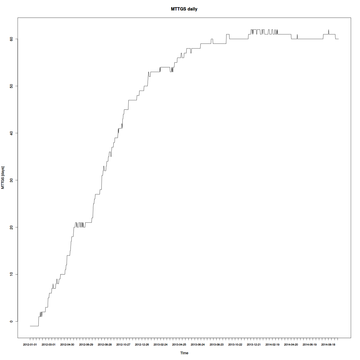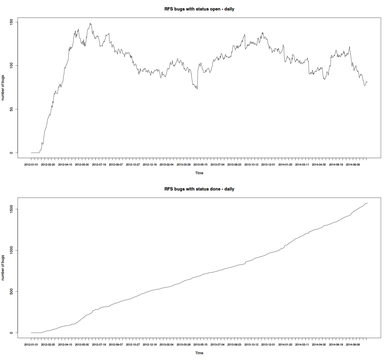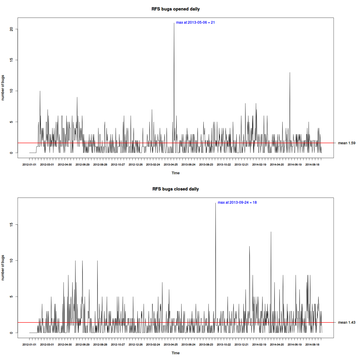Dariusz Dwornikowski: statistics of RFS bugs and sponsoring process
For some days I have been working on statistics of the sponsoring process in Debian. I find
this to be one of the most important things that Debian has to attract and enable new contributions.
It is important to know how this process works, whether we need more sponsors, how effective is the
sponsoring and what are the timings connected to it.
How I did this ?
I have used Debbugs SOAP interface to get all bugs that are filed against  As you can see, the trend is roughly exponential and MTTGS tends to settle around 60 days at the end of the
year 2013. This does not mean that your package will wait 60 days on average nowadays to get
sponsored. I remind that this is a global MTTGS, so even if the MTTGS of last month was very low, the global MTTGS would decrease
just slightly. It gives, however, a good glance in performance of the process. Even that more
packages are filed for sponsoring (see next graphs) now, than in the beginning of the epoch, the
sponsoring rate is high enough to flatten the global MTTGS, and with time maybe decrease it.
The image below (click for a larger one) shows how many bugs reside in a queue with status open or
closed (calculated for each day). For closed we have an almost linear function, so each day more or less the same amount of
bugs are closed and they increase the pool of bugs with status closed. For bugs with status open the
interesting part begins around May 2012 after the system is saturated or gets popular. It can be interpreted
as a plot of how many bugs reside in the queue, the important part is that it is stable and does not
show clear increasing trend.
As you can see, the trend is roughly exponential and MTTGS tends to settle around 60 days at the end of the
year 2013. This does not mean that your package will wait 60 days on average nowadays to get
sponsored. I remind that this is a global MTTGS, so even if the MTTGS of last month was very low, the global MTTGS would decrease
just slightly. It gives, however, a good glance in performance of the process. Even that more
packages are filed for sponsoring (see next graphs) now, than in the beginning of the epoch, the
sponsoring rate is high enough to flatten the global MTTGS, and with time maybe decrease it.
The image below (click for a larger one) shows how many bugs reside in a queue with status open or
closed (calculated for each day). For closed we have an almost linear function, so each day more or less the same amount of
bugs are closed and they increase the pool of bugs with status closed. For bugs with status open the
interesting part begins around May 2012 after the system is saturated or gets popular. It can be interpreted
as a plot of how many bugs reside in the queue, the important part is that it is stable and does not
show clear increasing trend.
 The last plot shows arrival and departure rate of bugs from RFS queue, i.e. how many bugs are opened
and closed each day. The interesting part here are the maxima. Let's look at them.
The last plot shows arrival and departure rate of bugs from RFS queue, i.e. how many bugs are opened
and closed each day. The interesting part here are the maxima. Let's look at them.
 Maximal number of opened bugs (21) was on 2012-05-06. As it appears it was a bunch upload of RFSs
for
Maximum number of closed bugs (18) was on 2013-09-24, and as you probably guessed right also tryton modules had impact on that.
The software
Most of the software was written in Python. Graphs were generated in R. After a code cleanup I will
publish a complete solution on my github account, free to use by everybody. If you would like to see
another statistics, please let me know, I can create them if the data provides sufficient
information.
Maximal number of opened bugs (21) was on 2012-05-06. As it appears it was a bunch upload of RFSs
for
Maximum number of closed bugs (18) was on 2013-09-24, and as you probably guessed right also tryton modules had impact on that.
The software
Most of the software was written in Python. Graphs were generated in R. After a code cleanup I will
publish a complete solution on my github account, free to use by everybody. If you would like to see
another statistics, please let me know, I can create them if the data provides sufficient
information.
sponsorship-requests
pseudo package. SOAP gives a little bit of overhead because it needs to download a complete list of
bugs for the sponsorship-requests package, and then process them according to given date ranges.
The same information can be easily extracted from the UDD database in the future, it will be faster
because SQL is better when working with date ranges than python obviously.
The most problematic part was getting the "real done date" of a particular bug, and frankly most of
my time I have spent on writing a rather dirty and complicated script. The script gets a log for a
particular bug number and returns a "real done date". I have published a proof of concept in a
previous post..
What I measured ?
RFSs is a queue, and in every queue one is interested in a mean time to get processed. In this case I
called the metric global MTTGS (mean time to get sponsored). This is a metric that gives the overall
performance insight in RFS queue. Time to get sponsored (TTGS) for a bug is a number of days that
passed between filing an RFS bug and closing it (bug was sponsored). Mean time to get sponsored is calculated as
a sum of TTGSs of all bugs divided by number of bugs (in a given period of time). Global MTTGS is
MTTGS calculated for a period of time 2012-1-1 until today().
Besides MTTGS I have also measured typical bug related metrics:
- number of bugs closed in a given day,
- number of bugs opened in a given day,
- number of bugs with status open in a given day,
- number of bugs with status closed in a given day.
 As you can see, the trend is roughly exponential and MTTGS tends to settle around 60 days at the end of the
year 2013. This does not mean that your package will wait 60 days on average nowadays to get
sponsored. I remind that this is a global MTTGS, so even if the MTTGS of last month was very low, the global MTTGS would decrease
just slightly. It gives, however, a good glance in performance of the process. Even that more
packages are filed for sponsoring (see next graphs) now, than in the beginning of the epoch, the
sponsoring rate is high enough to flatten the global MTTGS, and with time maybe decrease it.
The image below (click for a larger one) shows how many bugs reside in a queue with status open or
closed (calculated for each day). For closed we have an almost linear function, so each day more or less the same amount of
bugs are closed and they increase the pool of bugs with status closed. For bugs with status open the
interesting part begins around May 2012 after the system is saturated or gets popular. It can be interpreted
as a plot of how many bugs reside in the queue, the important part is that it is stable and does not
show clear increasing trend.
As you can see, the trend is roughly exponential and MTTGS tends to settle around 60 days at the end of the
year 2013. This does not mean that your package will wait 60 days on average nowadays to get
sponsored. I remind that this is a global MTTGS, so even if the MTTGS of last month was very low, the global MTTGS would decrease
just slightly. It gives, however, a good glance in performance of the process. Even that more
packages are filed for sponsoring (see next graphs) now, than in the beginning of the epoch, the
sponsoring rate is high enough to flatten the global MTTGS, and with time maybe decrease it.
The image below (click for a larger one) shows how many bugs reside in a queue with status open or
closed (calculated for each day). For closed we have an almost linear function, so each day more or less the same amount of
bugs are closed and they increase the pool of bugs with status closed. For bugs with status open the
interesting part begins around May 2012 after the system is saturated or gets popular. It can be interpreted
as a plot of how many bugs reside in the queue, the important part is that it is stable and does not
show clear increasing trend.
 The last plot shows arrival and departure rate of bugs from RFS queue, i.e. how many bugs are opened
and closed each day. The interesting part here are the maxima. Let's look at them.
The last plot shows arrival and departure rate of bugs from RFS queue, i.e. how many bugs are opened
and closed each day. The interesting part here are the maxima. Let's look at them.
 Maximal number of opened bugs (21) was on 2012-05-06. As it appears it was a bunch upload of RFSs
for
Maximal number of opened bugs (21) was on 2012-05-06. As it appears it was a bunch upload of RFSs
for tryton-modules-*..
706953 RFS: tryton-modules-account-stock-anglo-saxon/2.8.0-1
706954 RFS: tryton-modules-purchase-shipment-cost/2.8.0-1
706948 RFS: tryton-modules-production/2.8.0-1
706969 RFS: tryton-modules-account-fr/2.8.0-1
706946 RFS: tryton-modules-project-invoice/2.8.0-1
706950 RFS: tryton-modules-stock-supply-production/2.8.0-1
706942 RFS: tryton-modules-product-attribute/2.8.0-1
706957 RFS: tryton-modules-stock-lot/2.8.0-1
706958 RFS: tryton-modules-carrier-weight/2.8.0-1
706941 RFS: tryton-modules-stock-supply-forecast/2.8.0-1
706955 RFS: tryton-modules-product-measurements/2.8.0-1
706952 RFS: tryton-modules-carrier-percentage/2.8.0-1
706949 RFS: tryton-modules-account-asset/2.8.0-1
706904 RFS: chinese-checkers/0.4-1
706944 RFS: tryton-modules-stock-split/2.8.0-1
706981 RFS: distcc/3.1-6
706945 RFS: tryton-modules-sale-supply/2.8.0-1
706959 RFS: tryton-modules-carrier/2.8.0-1
706951 RFS: tryton-modules-sale-shipment-cost/2.8.0-1
706943 RFS: tryton-modules-account-stock-continental/2.8.0-1
706956 RFS: tryton-modules-sale-supply-drop-shipment/2.8.0-1
706953 RFS: tryton-modules-account-stock-anglo-saxon/2.8.0-1
706954 RFS: tryton-modules-purchase-shipment-cost/2.8.0-1
706948 RFS: tryton-modules-production/2.8.0-1
706969 RFS: tryton-modules-account-fr/2.8.0-1
706946 RFS: tryton-modules-project-invoice/2.8.0-1
706950 RFS: tryton-modules-stock-supply-production/2.8.0-1
706942 RFS: tryton-modules-product-attribute/2.8.0-1
706958 RFS: tryton-modules-carrier-weight/2.8.0-1
706941 RFS: tryton-modules-stock-supply-forecast/2.8.0-1
706955 RFS: tryton-modules-product-measurements/2.8.0-1
706952 RFS: tryton-modules-carrier-percentage/2.8.0-1
706949 RFS: tryton-modules-account-asset/2.8.0-1
706944 RFS: tryton-modules-stock-split/2.8.0-1
706959 RFS: tryton-modules-carrier/2.8.0-1
723991 RFS: mapserver/6.4.0-2
706951 RFS: tryton-modules-sale-shipment-cost/2.8.0-1
706943 RFS: tryton-modules-account-stock-continental/2.8.0-1
706956 RFS: tryton-modules-sale-supply-drop-shipment/2.8.0-1